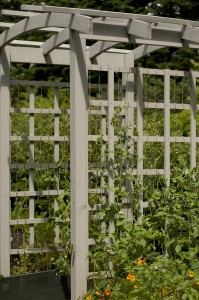Tip of the Week: Ornamental Vegetable Garden Design
Posted in Exhibitions, Gardening Tips, The Edible Garden on June 21 2010, by Sonia Uyterhoeven
 |
Sonia Uyterhoeven is Gardener for Public Education. Join her each weekend for home gardening demonstrations on a variety of topics in the Home Gardening Center. |
 While it is commonplace to invest a considerable amount of thought, energy, and pride in the design of our gardens, herbaceous borders in particular, the vegetable garden often gets overlooked and undervalued as a potential site for artistic excellence.
While it is commonplace to invest a considerable amount of thought, energy, and pride in the design of our gardens, herbaceous borders in particular, the vegetable garden often gets overlooked and undervalued as a potential site for artistic excellence.
However, ornamental vegetable gardens have a long-standing tradition. The Persians filled their walled gardens with fruit trees and edible plants, adorning these places of refuge while providing food for the table. The Cloisters Museum & Gardens, a branch of the Metropolitan Museum of Art in Manhattan’s Fort Tryon Park, is a wonderful example of how medieval courtyards were home to the cultivation of culinary and medicinal herbs while providing a place for peaceful retreat.
Inspiration can be found in many historic restorations of ornamental vegetable gardens, ranging from the Grande Potagér at Chateau de Villandry in France to England’s Lost Gardens of Heligan and the walled Victorian kitchen garden at Chilton Foliat. Closer to home, Thomas Jefferson’s historic gardens at Monticello in Virginia celebrate America’s vegetable gardening tradition.
The potagér, derived from the French word meaning soup, was designed with seasonal ingredients that would end up in your crock. Similarly, English kitchen gardens were those in which grew anything that could be placed on your kitchen table, ranging from cut flowers to fruits and vegetables.
Ornamental vegetable gardens can be formal gardens with symmetrical designs and neatly delineated beds, or they can be informal, cottage-style gardens with sweeping drifts, intermingled plants, and a colorful, playful exuberance. The garden can be as small as a window box or as large as space accommodates.
After choosing a suitable site—most vegetables need good drainage and full sun, although a few will tolerate light shade—the design process can begin. The following basic tenets of garden design will help to direct and inform your choices.
Good Garden Design
First, decide the type of garden you would like to create. Often it is useful to draw on successful examples of what has worked for others. Or, you can choose a theme: Do you want to create a pizza garden, a rainbow garden, a medieval herb garden, a French potagér, a Mexican garden, a Native American garden, or an heirloom garden? Will color dictate your choices? The possibilities are endless.
Once you have established a vision for the garden, consider cohesive elements such as symmetry, balance, and repetition. Shapes, patterns, colors, textures, architectural features, or particular plants can all be repeated to unify a design.
Attention to color and texture is just as important in the vegetable garden as it is in the herbaceous border. Color harmonies and complements can easily be achieved with the use of heirloom vegetables and a vast array of cottage-garden flowers.
Finally, create focal points and vertical accents for visual interest. Focal points can be a cozy seating area, a bench, a pergola, or well-placed strawberry pots and urns. Vertical accents such as trellises, teepees, A-frames, pea-stakes, and tuteurs often are functional as well as attractive, providing vines and indeterminate tomatoes a place to climb and display their goods.
Don’t forget to include decorative garden art. Large ornamental urns or pots blend effortlessly into many designs. Think beyond scarecrows and decorate your garden with features that are fun and fanciful as well as beautiful. Garden furniture can be painted in cheerful colors to match the energy of the site.
Next week I’ll talk about basic features of the vegetable garden.

